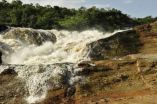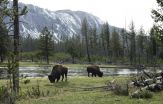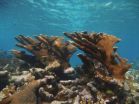(Press-News.org) A fundamental step-change involving an increase in funding and political commitment is urgently needed to ensure that protected areas deliver their full conservation, social and economic potential, according to an article published today in Nature by experts from Wildlife Conservation Society, the University of Queensland, and the IUCN World Commission on Protected Areas (WCPA).
The paper, The performance and potential of protected areas, comes ahead of the IUCN World Parks Congress 2014 – a once-in-a-decade global forum on protected areas opening next week in Sydney, Australia.
To access the paper, click here.
According to the authors, allocating US$45 - $76 billion to protected areas annually – just 2.5% of the global annual military expenditure – could help adequately manage those areas, ensuring their potential contribution to the well-being of the planet is fully met.
Many threatened species, such as the Asian elephant, the tiger, and all rhinoceros species, as well as numerous plants, reptiles and amphibians, survive thanks to protected areas. Well-managed marine protected areas contain more than five times the total large fish biomass and 14 times the shark biomass compared with fished areas.
"Protected areas offer us solutions to some of today's most pressing challenges" says Dr James Watson of the Wildlife Conservation Society and The University of Queensland and lead author of the study. "But by continuing with 'business as usual', we are setting them up for failure. A step-change in the way we value, fund, govern and manage those areas is neither impossible nor unrealistic and would only represent a fraction of what the world spends annually on defense."
According to the latest data, protected areas cover around 15% of land and 3% of oceans. Experts warn, however, that despite the significant increase in their coverage over the past century, this is still short of the global 2020 targets to protect at least 17% of land and 10% of oceans. Many ecosystems remain poorly conserved because protected areas do not always encompass the most important areas for biodiversity.
In addition, the vast majority of existing protected areas that are well placed do not have sufficient resources to be effective, with some studies finding as few as one quarter of them are being effectively managed. Growing threats from climate change and the escalating poaching crisis place additional pressures on protected areas globally.
"Some of the most iconic protected areas, such as Ecuador's Galapagos National Park, are undergoing significant degradation, partly due to an inability to manage them effectively," says Professor Marc Hockings of The University of Queensland,co-author of the study and member of the IUCN WCPA. "But governments cannot be solely responsible for ensuring that protected areas fulfill their potential. We need to find new, innovative ways to fund and manage them, actively involving government, business and community groups."
The paper also highlights an alarming increase in governments - in both developing and developed countries – backtracking on their commitments through funding cuts and changes in policy. A recent global analysis has documented 543 instances where protected areas saw their status downgraded or removed altogether.
For example, recent cuts to the Parks Canada budget have reduced conservation spending by 15%¬. In Uganda, active oil exploration and development is occurring inside many protected areas, including Murchison Falls National Park. In Indonesia, in 2010, mining permits were issued inside 481,000 hectares of protected areas and in the Virgin Komi Forests in Russia, significant boundary changes have been made to reserves such as the Yugyd Va National Park to allow mining. The Arabian Oryx Sanctuary in Oman was removed from the World Heritage List after the government reduced the size of the reserve by 90% to allow for oil and gas extraction.
"There is a fundamental need for an increase in support of global protected areas, including better recognition, funding, planning and enforcement" says Nigel Dudley, co-author of the paper, from Equilibrium Research and The University of Queensland, member of the IUCN WCPA. "It is government's responsibility to step up but there is also the need for the wider community to take collective responsibility for protected areas."
Protected areas conserve biodiversity and sustain a large proportion of the world's poorest people by providing them with food, water, shelter and medicine. They play a key part in climate change mitigation and adaptation and bolster national economies through tourism revenues. In Rwanda, for example, tourism revenue from visits to see mountain gorillas inside Volcanoes National Park is now the country's largest source of foreign exchange, raising US$200 million annually. In Australia, the 2012–2013 budget for the Great Barrier Reef Marine Park Authority was approximately AUS$50 million, but tourism to the reef was worth more than A$5.2 billion annually to the Australian economy.
"The growth of the modern global protected area movement over the last 100 years is arguably the greatest conservation achievement," says Julia Marton-Lefèvre, IUCN Director General. "It is also increasingly important for livelihoods and global security. The key now is for countries to recognize the return on investment that protected areas offer and realize that those places are fundamental to the future of life on earth. This is exactly what we hope to achieve at the upcoming IUCN World Parks Congress."
Effective management of protected areas, the threats they face and the solutions they offer to today's global challenges will be discussed at the IUCN World Parks Congress taking place in Sydney from 12 to 19 November 2014.
INFORMATION:
Sometimes, words just complicate things. What if our brains could communicate directly with each other, bypassing the need for language?
University of Washington researchers have successfully replicated a direct brain-to-brain connection between pairs of people as part of a scientific study following the team's initial demonstration a year ago. In the newly published study, which involved six people, researchers were able to transmit the signals from one person's brain over the Internet and use these signals to control the hand motions of another person within a split ...
DALLAS – November 5, 2014 – UT Southwestern Medical Center physician-researchers found that 1-in-5 parents of overweight Latino children is not directly told that the child is overweight. Furthermore, sometimes no discussion of weight occurred when a language barrier existed – a finding that signifies the challenges of reversing the rapidly rising rates of obesity in minority children. The study is published in the November edition of the journal Pediatrics.
In recent years, obesity has become a prevalent health concern for children of all races in the ...
ROSEMONT, Ill.—Osteoporosis, a common condition causing progressive bone loss and increased fracture risk, is primarily thought of as a disease affecting older women. And yet, up to one in four men over age 50 will break a bone due to osteoporosis. A study in the November 5 issue of the Journal of Bone & Joint Surgery (JBJS) found that men were three times less likely than women to undergo bone mass density (BMD) testing following a broken wrist (distal radius fracture) and seven times less likely to begin treatment for osteoporosis.
With an aging U.S. population, ...
Research from the University of Leeds and an international team of scientists has shown a recent increase in atmospheric hydrogen chloride (HCI), a substance linked to destruction of the ozone layer.
It was anticipated that there would be a decline in HCI under the Montreal Protocol, the international treaty designed to protect the ozone layer by phasing out the production of ozone-depleting substances.
Dr Emmanuel Mahieu from the University of Liège in Belgium, who led the research, explained: "It's important to say that the Montreal Protocol is still on track, ...
The first fossil of an amphibious ichthyosaur has been discovered in China by a team led by researchers at the University of California, Davis. The discovery is the first to link the dolphin-like ichthyosaur to its terrestrial ancestors, filling a gap in the fossil record. The fossil is described in a paper published in advance online Nov. 5 in the journal Nature.
The fossil represents a missing stage in the evolution of ichthyosaurs, marine reptiles from the Age of Dinosaurs about 250 million years ago. Until now, there were no fossils marking their transition from land ...
Many fire scientists have tried to get Smokey the Bear to hang up his "prevention" motto in favor of tools like thinning and prescribed burns, which can manage the severity of wildfires while allowing them to play their natural role in certain ecosystems.
But a new international research review led by the University of California, Berkeley, says the debate over fuel-reduction techniques is only a small part of a much larger fire problem that will make society increasingly vulnerable to catastrophic losses unless it changes its fundamental approach from fighting fire ...
BOSTON – Each year nearly two million Americans suffer osteoporosis-related fractures, and as the population ages that number is expected to increase dramatically, placing a major burden on the health care system. While osteoporosis prevention and treatment efforts have historically been focused on post-menopausal women, a new study from Beth Israel Deaconess Medical Center (BIDMC) suggests that critical opportunities are being lost by not focusing more attention on bone loss and fracture risk in older men.
"Given that the prevalence of fragility fractures among ...
When it comes to genitalia, nature enjoys variety. Snakes and lizards have two. Birds and people have one. And while the former group's paired structures are located somewhat at the level of the limbs, ours, and the birds', appear a bit further down. In fact, snake and lizard genitalia are derived from tissue that gives rise to hind legs, while mammalian genitalia are derived from the tail bud. But despite such noteworthy contrasts, these structures are functionally analogous and express similar genes.
How do these equivalent structures arise from different starting ...
Scientists from the Department of Energy's SLAC National Accelerator Laboratory and the University of California, Los Angeles have shown that a promising technique for accelerating electrons on waves of plasma is efficient enough to power a new generation of shorter, more economical accelerators. This could greatly expand their use in areas such as medicine, national security, industry and high-energy physics research.
This achievement is a milestone in demonstrating the practicality of plasma wakefield acceleration, a technique in which electrons gain energy by essentially ...
AMHERST, Mass. – The surprise discovery of the fossilized skull of a 66- to 70-million-year-old, groundhog-like creature on Madagascar has led to new analyses of the lifestyle of the largest known mammal of its time by a team of specialists including biologist Elizabeth Dumont at the University of Massachusetts Amherst, an expert in jaw structure and bite mechanics.
The skull of this animal, named Vintana sertichi, was found in a geological formation deposited when a great variety of dinosaurs roamed the earth. With a skull that is almost five inches (125 mm) ...








